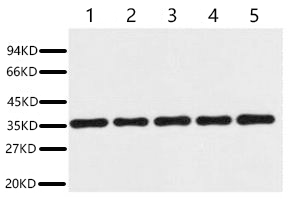| Product name | Anti-GAPDH Rabbit Polyclonal Antibody |
| Immunogen | Recombinant Protein |
| Host | Rabbit |
| Reactivity | Chicken, Human, Monkey, Mouse, Rabbit, Rat, Sheep, Xenopus laevis |
| Applications | IHC-P, WB |
| Applications notes | Optimal working dilutions should be determined experimentally by the investigator. Suggested starting dilutions are as follows: WB (1:10000), IHC-P (1:200). |
| Clonality | Polyclonal |
| Preparation method | The antibody was affinity-purified from rabbit antiserum by affinity-chromatography using specific immunogen |
| Alternative | GAPDH; GAPD; CDABP0047; OK/SW-cl.12; Glyceraldehyde-3-phosphate dehydrogenase; GAPDH; Peptidyl-cysteine S-nitrosylase GAPDH |
| Formulation | Liquid solution |
| Concentration | 1 mg/ml |
| Storage buffer | PBS, pH 7.4, containing 0.02% Sodium Azide as preservative and 50% Glycerol. |
| Storage instructions | Stable for one year at -20°C from date of shipment. For maximum recovery of product, centrifuge the original vial after thawing and prior to removing the cap. Aliquot to avoid repeated freezing and thawing. |
| Shipping | Gel pack with blue ice. |
| Precautions | The product listed herein is for research use only and is not intended for use in human or clinical diagnosis. Suggested applications of our products are not recommendations to use our products in violation of any patent or as a license. We cannot be responsible for patent infringements or other violations that may occur with the use of this product. |
| Background | GAPDH encodes a member of the glyceraldehyde-3-phosphate dehydrogenase protein family. Glyceraldehyde-3-phosphate dehydrogenase has been identified as a moonlighting protein based on its ability to perform mechanistically distinct functions. The product of GAPDH catalyzes an important energy-yielding step in carbohydrate metabolism, the reversible oxidative phosphorylation of glyceraldehyde-3-phosphate in the presence of inorganic phosphate and nicotinamide adenine dinucleotide (NAD). Glyceraldehyde-3-phosphate dehydrogenase has additionally been identified to have uracil DNA glycosylase activity in the nucleus. Also, Glyceraldehyde-3-phosphate dehydrogenase contains a peptide that has antimicrobial activity against E. coli, P. aeruginosa, and C. albicans. Studies of a similar protein in mouse have assigned a variety of additional functions including nitrosylation of nuclear proteins, the regulation of mRNA stability, and acting as a transferrin receptor on the cell surface of macrophage. Many pseudogenes similar to this locus are present in the human genome. Alternative splicing results in multiple transcript variants. |
| Gene ID | 2597 |
| Alternative | GAPDH; GAPD; CDABP0047; OK/SW-cl.12; Glyceraldehyde-3-phosphate dehydrogenase; GAPDH; Peptidyl-cysteine S-nitrosylase GAPDH |
| Others | The antibody detects endogenous GAPDH protein. |
| Accession | P04406 |
| Observed Band(KD) | 37 |

Fig. Western blot analysis of 293T (1), Rat brain (2), NIH 3T3 (3), Sheep Muscle (4), Rabbit testis (5), diluted at 1:20000. Secondary antibody was diluted at 1:20000.
Author:J Sun, R Wang, T Chao, J Peng, C Wang Publication name:Journal of Ginseng IF:6.06
Author:T Wu, Q Tian, R Liu, K Xu, S Shi Publication name:Journal of Cellular and Molecular Medicine IF:5.295
Author:Wu L, Ye S, Yao Y, et al. Publication name:Stem cells international IF:5.131
Author:Shen, Aling, et al. Publication name:Scientific Reports IF:4.6
Author:Yangfeng Chen, Zhijun Wang Publication name:Genes (Basel) IF:3.759
Author:Qiao Y, Liu H, He C, et al Publication name:Neuroscience IF:3.3
Author:P Hu, L Ma, ZQ Wu, GY Zheng Publication name:European Review for Medical and Pharmacological Sciences.2019; 23: 877-884. IF:2.21
Author:Huang A, Pi D, Chen Y, et al. Publication name:Research Square IF:/
You must be logged in to post a review.
Reviews
There are no reviews yet.